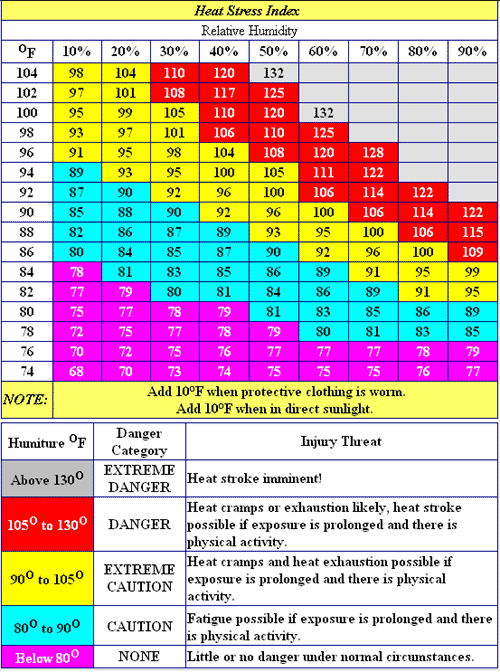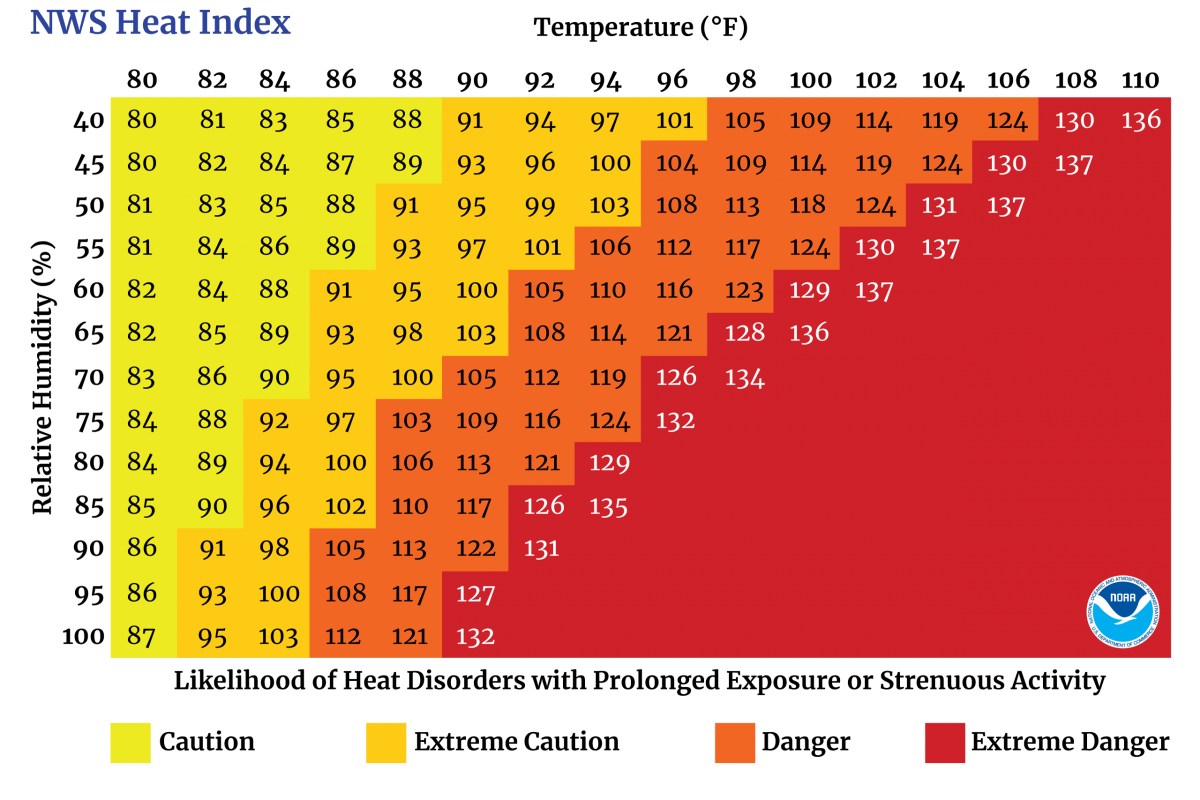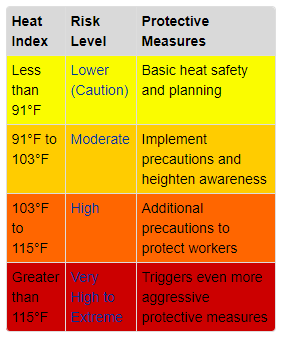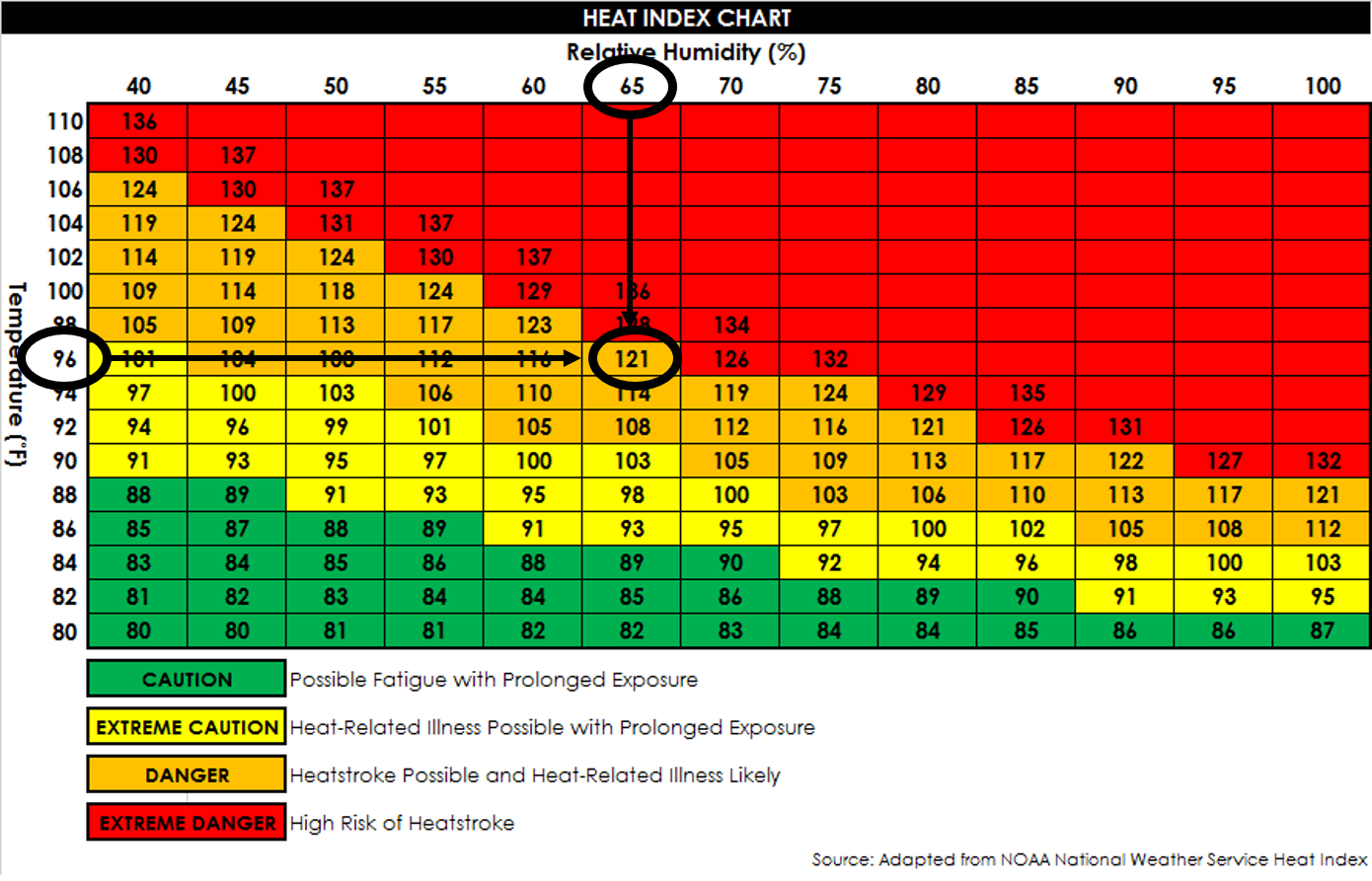The heat index is a crucial factor to consider when it comes to ensuring safety in the workplace, especially in industries that involve strenuous physical activities or exposure to high temperatures. Understanding the heat index and its implications can help prevent heat-related illnesses and ensure the well-being of employees. In this post, we will explore the importance of heat index monitoring and provide valuable resources to help you protect your workforce.
Heat Index: OSHA Heat Index Chart
 One of the most widely recognized resources for heat index information is the OSHA Heat Index Chart. This chart takes into account both temperature and humidity to determine the perceived temperature or how hot it feels. By using this chart, employers can assess the risk level associated with specific heat index values and take appropriate preventive measures. It is crucial to educate workers about the heat index and provide guidelines on how to respond to different heat stress levels.
One of the most widely recognized resources for heat index information is the OSHA Heat Index Chart. This chart takes into account both temperature and humidity to determine the perceived temperature or how hot it feels. By using this chart, employers can assess the risk level associated with specific heat index values and take appropriate preventive measures. It is crucial to educate workers about the heat index and provide guidelines on how to respond to different heat stress levels.
Pin on My Health (and yours!)
 The health and well-being of employees should always be a top priority. This informative image highlights the importance of recognizing heat stress symptoms and provides helpful tips on how to stay safe during hot weather. It emphasizes the significance of drinking plenty of water, wearing appropriate clothing, and taking regular breaks in shaded or air-conditioned areas.
The health and well-being of employees should always be a top priority. This informative image highlights the importance of recognizing heat stress symptoms and provides helpful tips on how to stay safe during hot weather. It emphasizes the significance of drinking plenty of water, wearing appropriate clothing, and taking regular breaks in shaded or air-conditioned areas.
Printable OSHA Heat Index Chart - Printable Blank World

Heat Safety in the Workplace | Environmental Safety, Sustainability, and
 This image emphasizes the importance of heat safety in the workplace. It highlights the impact of high temperatures on the human body and outlines the potential health hazards associated with heat stress. By implementing appropriate preventive measures, such as providing adequate shade and hydration stations, ensuring proper ventilation, and scheduling breaks in cool areas, employers can promote a safe and healthy work environment.
This image emphasizes the importance of heat safety in the workplace. It highlights the impact of high temperatures on the human body and outlines the potential health hazards associated with heat stress. By implementing appropriate preventive measures, such as providing adequate shade and hydration stations, ensuring proper ventilation, and scheduling breaks in cool areas, employers can promote a safe and healthy work environment.
Promoting Heat Safety in Construction - Perlo Construction
 The construction industry often involves physically demanding tasks and prolonged exposure to the elements. This image focuses on promoting heat safety specifically in the construction sector. It highlights the importance of implementing comprehensive heat illness prevention programs, training workers on recognizing the signs of heat-related illnesses, and taking appropriate actions to mitigate risks. By prioritizing heat safety, companies can ensure the well-being of their workforce and prevent work-related incidents.
The construction industry often involves physically demanding tasks and prolonged exposure to the elements. This image focuses on promoting heat safety specifically in the construction sector. It highlights the importance of implementing comprehensive heat illness prevention programs, training workers on recognizing the signs of heat-related illnesses, and taking appropriate actions to mitigate risks. By prioritizing heat safety, companies can ensure the well-being of their workforce and prevent work-related incidents.
Heat Index Chart – Grainger Industrial Supply
 Grainger Industrial Supply offers a comprehensive heat index chart that categorizes heat stress risk levels based on temperature and humidity. This resource can be used to determine the appropriate protective measures and establish guidelines for work activities under different heat stress conditions. By referring to this chart, employers can make informed decisions to protect their employees and minimize heat-related incidents.
Grainger Industrial Supply offers a comprehensive heat index chart that categorizes heat stress risk levels based on temperature and humidity. This resource can be used to determine the appropriate protective measures and establish guidelines for work activities under different heat stress conditions. By referring to this chart, employers can make informed decisions to protect their employees and minimize heat-related incidents.
Heat Stress and Worker Safety
 Heat stress can have a significant impact on worker safety and productivity. This image sheds light on the various factors that contribute to heat stress, such as high temperatures, humidity, and physical exertion. It emphasizes the importance of effective heat stress management, including the provision of adequate water supply, rest breaks, and training programs that educate workers about the risks and prevention strategies.
Heat stress can have a significant impact on worker safety and productivity. This image sheds light on the various factors that contribute to heat stress, such as high temperatures, humidity, and physical exertion. It emphasizes the importance of effective heat stress management, including the provision of adequate water supply, rest breaks, and training programs that educate workers about the risks and prevention strategies.
Heat Stress Monitoring - OHSA Occupational Health Services Australia
 Monitoring heat stress levels is crucial to ensure the well-being of workers, particularly in industries that involve working in high-temperature environments. This image demonstrates a heat stress monitoring chart that enables employers to assess the heat stress risk and implement appropriate control measures. Regular monitoring helps identify potential concerns and establish proactive measures to minimize heat-related illnesses.
Monitoring heat stress levels is crucial to ensure the well-being of workers, particularly in industries that involve working in high-temperature environments. This image demonstrates a heat stress monitoring chart that enables employers to assess the heat stress risk and implement appropriate control measures. Regular monitoring helps identify potential concerns and establish proactive measures to minimize heat-related illnesses.
Do You Know Today’s Heat Index? - LHSFNA
Being aware of the current heat index is essential for everyone, including employers, employees, and individuals working outdoors. This image emphasizes the importance of knowing the heat index on a given day and taking necessary precautions accordingly. It is crucial to stay updated on weather conditions and plan work activities accordingly, modifying schedules or implementing additional safety measures when temperatures rise.
Prevent Heat Illness with OSHA’s Help | Linda Light, LLCLinda Light, LLC
 Linda Light, LLC highlights the assistance provided by OSHA in preventing heat illness. The image illustrates the importance of using the OSHA Heat Safety Tool mobile app, which provides real-time heat index information and allows users to calculate the heat index and associated risk levels. This resource enables employers and employees to stay informed and take proactive steps to prevent heat-related illnesses.
Linda Light, LLC highlights the assistance provided by OSHA in preventing heat illness. The image illustrates the importance of using the OSHA Heat Safety Tool mobile app, which provides real-time heat index information and allows users to calculate the heat index and associated risk levels. This resource enables employers and employees to stay informed and take proactive steps to prevent heat-related illnesses.
In conclusion, understanding and monitoring the heat index is vital in ensuring the safety and well-being of workers, especially in high-temperature work environments. By using resources such as the OSHA Heat Index Chart, recognizing heat stress symptoms, and implementing appropriate preventive measures, employers can effectively mitigate the risks associated with heat-related illnesses. Stay informed, stay safe, and prioritize the health and safety of your workforce.